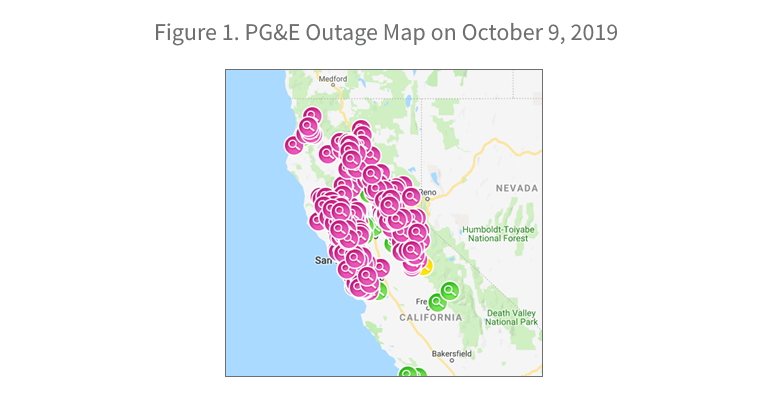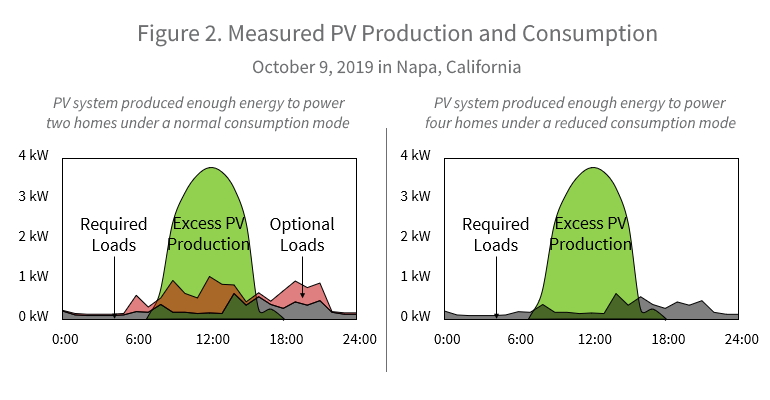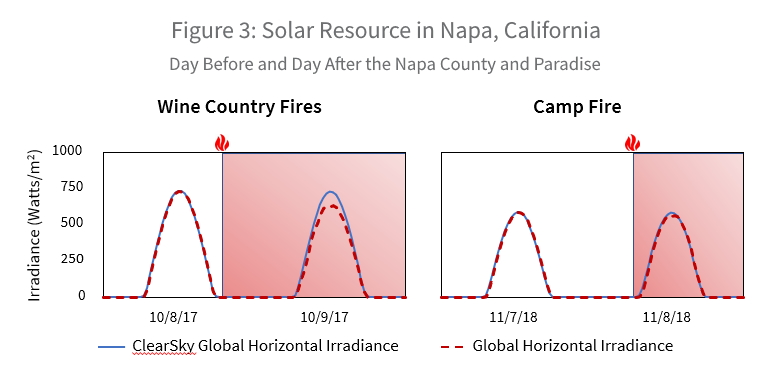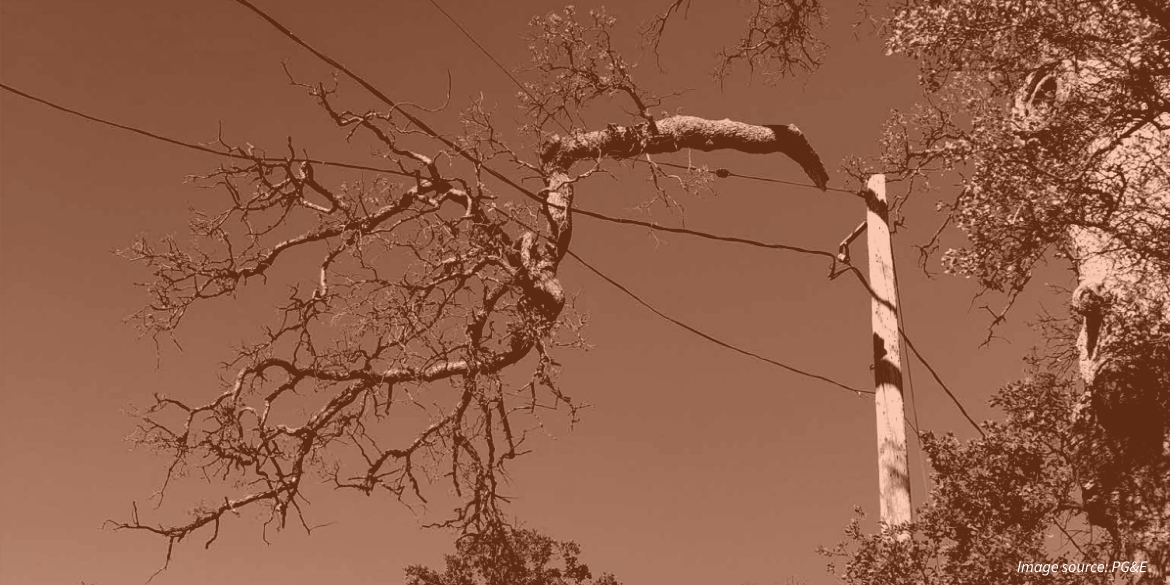Wildfires & California: A major concern
California has experienced multiple devastating wildfires over the past two years. The Wine Country Fires that started on October 8, 2017, in Napa County killed 44 people and cost $15 billion. The Camp Fire, an even more devasting fire that started on November 8, 2018, killed 85 people, destroyed the town of Paradise and cost $16 billion.
Precautionary power outages: A dilemma
In anticipation of fires that could be started by power lines, Pacific Gas and Electric (PG&E) proactively shut off power to major sections of Northern California starting on October 8, 2019. The outage eventually affected about 738,000 people from Santa Cruz to the California/Oregon border. Bloomberg estimates that this disruption could cost the California economy $2.6 billion. Cost to the economy notwithstanding, PG&E is already suffering reputational damage.

Solar + storage for everyone: realistic?
For some people within the clean energy space—and the solar industry specifically—the solution may be obvious: equip every home or business with solar + storage (i.e., a PV and battery system) to provide electricity during precautionary power outages. This solution would allow a home or business to continue to operate even if the grid goes down. This is the “every person for themselves” approach.
Indeed, while a solar + storage system has the potential to address an individual consumer’s predicament, it’s not a feasible option for everyone. For example, personal solar + storage may not be possible for people that rent a home, live in multi-family housing (e.g., apartments or condominiums) or simply can’t afford it.
Adoption of solar + storage by all homeowners and businesses is not realistic. Nor does it broadly or optimally address the challenge of massive electrical outages. However, there may be a solution to the dilemma of fire risk or power outages that would incorporate existing and new solar + storage installations and benefit everyone.
There is a better (and cheaper) approach that would benefit everyone
Precautionary, wind-related, power outages are likely to have both direct and indirect effects. The direct effect is the loss of power where the winds are high. The indirect effect is loss of power where the winds are not high, but where there is insufficient transmission and distribution capacity available to deliver power to everyone.
If a utility must disconnect high-power transmission lines during times of high winds and increased fire risk, a utility could conceptually avoid shutting off power to indirectly affected customers by taking these three steps:
- Support increased solar + storage adoption
- Encourage load reduction during emergencies
- Encourage a solar + storage supply-side solution
Support solar + storage adoption
While 100% adoption of residential solar + storage is impractical, an expanded network of solar + storage systems could be an integral element to solving the fire risk vs. grid reliability dilemma.
In 2007, California instituted the California Solar Initiative (CSI), an aggressive PV incentive program that has stimulated significant growth in California’s distributed solar market (read: residential solar panels). The budget for the CSI program was approximately $2.2 billion over its primary operating period of 2007 and 2016. To put this into context, this is less than the cost of Bloomberg’s estimate of the economic impact of the latest outage. Today, we see one-million solar PV systems installed in California.
Looking forward, we can expect that solar + storage systems will continue to improve in terms of efficiency and reduced systems costs. If efficiencies continue to improve and prices continue to decline, we could easily forecast increased growth of solar + battery systems over the next decade in California.
While this is good news for consumers and businesses, this may present some challenges to utilities in terms of managing and tracking the deployment of solar + storage systems (and other distributed energy resources or DERs) on their networks. There are real challenges to managing and tracking all types of DERs on a utility’s network. That said, a larger solar + storage network will enable the supply-side element described below.
Encourage load reduction
During energy emergencies, a utility could encourage residential and business customers to reduce power consumption to the point where the grid continues to operate albeit at a much more minimal level. “Minimal” implies a level of energy consumption that allows basic quality-of-life systems such as freezers, refrigerators, lights and small electronic devices to operate. This could be accomplished in two ways: improved communications and temporary economic incentives.
By developing more proactive consumer and business outreach methods during emergencies (SMS/text, email and more), utilities could help educate and proactively reduce demand. Utilities could develop methods that inform customers of emergencies and how they can help reduce the impact of an energy emergency.
In conjunction with improved communications, net load could be reduced by a utility adopting special energy emergency programs and financial incentives. Programs could incentivize consumers to reduce energy consumption during peak times. Financial incentives could encourage maximum energy export from both customer-owned PV and storage during the emergency. Together, this would reduce net load and all consumers would benefit, whether or not they owned solar or storage.
Think of this as the carrot and stick approach: design programs to minimize consumption when energy demand is high and provide credits to maximize energy export to satisfy reduced consumption needs. Reducing electrical load through voluntary, market-based methods could reduce the need for involuntary power outages and help make the supply-side strategy outlined next more feasible.
Encourage solar + storage supply-side solutions
If we accept that solar + battery system installations will grow, and that we can reduce demand during an emergency, there is an opportunity for a supply-side energy solution using solar + storage.
To supply needed electricity after some transmission and distribution lines have been shut down, thus restricting power flow into certain areas, it’s possible that distributed solar + storage systems could produce enough power to meet basic needs at specific locations. Existing system owners—already incentivized to reduce power consumption—could be further incentivized to send surplus electricity into the grid. This may make a minimal level of electricity available to all consumers in those indirectly affected areas during emergency periods.
Real-life example
Is it possible to meet minimum energy demands for residential customers with solar + storage? Yes, in concept, it is achievable. For illustrative purposes, consider an example using measured data for a single home during the October 2019 outage. This 3,000 sq. ft. home in Napa, Calif., had a PV system sized to meet its annual energy consumption.
The following figure shows that the PV system produced 23 kWh (green area) and used 12 kWh on October 9. This means that the PV system produced almost enough energy to power two typical homes during that day.

As the figure shows, however, some of the loads are “Required Loads/Minimal Loads” (gray areas) while some are “Optional Loads” (red areas). Required Loads include lights, refrigerator, freezer and small electronic devices. Optional Loads include water heating, cooking, dishwasher and washer/dryer.
This home could have used only 6 kWh by eliminating Optional Loads. This means that in a constrained usage mode, the PV system on this one house could have supplied enough energy to support up to four typical homes.
Extrapolating the example above to customers within a specific service area, there may have been enough existing distributed solar and stored power available to meet everyone’s minimal needs during the October 2019 electricity shutdown. The key to leveraging distributed solar PV production is storage (whether owned by customers or the utility), as well as a way to get customers to reduce consumption for short durations, perhaps only a day.
By taking advantage of distributed solar + storage, coupled with advanced messaging and control systems), a utility can BOTH reduce the impact of potential fires and maintain the reliability of the network by:
- Reducing demand during energy emergencies, and
- Leveraging solar+ battery installations for power.
However, there’s one potential question I want to field before it gets asked…
Would solar have been available at the time of the previous precautionary power outages?
The solution described above only works if there are solar resources (irradiance) available to produce power from PV solar systems. As mentioned above, the Wine Country Fires and the Camp Fire were devastating fires… so was solar available on these days?
Using SolarAnywhere® Data —a solar resource database produced by Clean Power Research—we can show the solar resource (as measured by the Global Horizontal Irradiance) that was available in Napa the day before and the day after the start of the two fires. The blue lines represent the amount of solar resource available on a clear day. The red dashed lines represent the actual amount of solar resource available on those days.

In both examples, the figures show clear skies the day before the fires. The day after the fires, the skies were mostly clear, except for a small reduction the day after the Wine Country Fires due to smoke. So, solar power could have been available and distributed to local residents.
The same was true around the time of the October 8, 2019 power outage. The skies were fairly clear the day before the precautionary power shut down, and they were totally clear the day the shutdown began. It’s hard to say if the sun will always shine the day prior to a fire risk emergency, but recent history suggests this approach may have avoided unnecessary electrical outages.
Getting utilities prepared
If utilities want to reduce the impact of precautionary outages due to fire risks and make sure some minimal level of power is available, Clean Power Research has several software tools presently helping utilities adapt to DERs today.
- PowerClerk® is widely used by utilities nationwide to operate incentive and interconnection programs for PVs, batteries and other Distributed Energy Resource (DER) technologies. The data within PowerClerk makes it possible for utilities to identify where distributed solar + storage systems are deployed, making managing and tracking more efficient.
- When combined with SolarAnywhere, the industry’s leading software for historical solar data and predictive modeling, it’s possible to precisely predict how much power solar PV systems can produce and are likely to produce over a specific time period.
It may be possible for utilities to get more value out of distributed solar + storage. By taking advantage of solar + storage currently deployed (and more coming online every day) and encouraging utility customers to temporarily reduce power consumption, the impact of future precautionary fire-related outages in California could be reduced.
